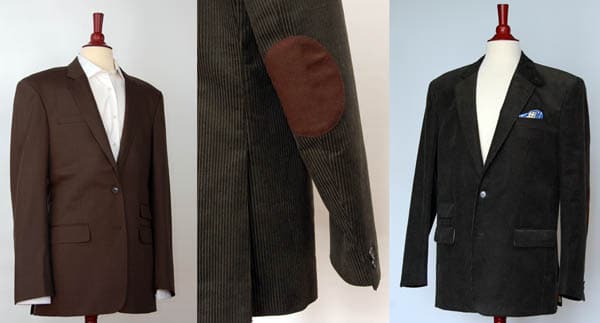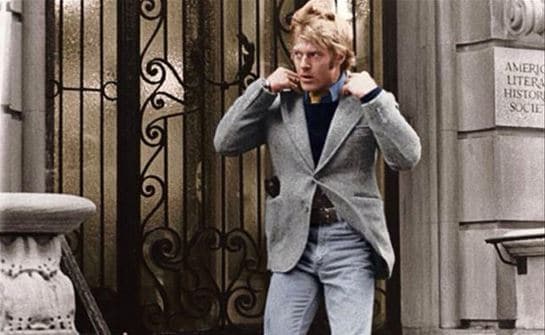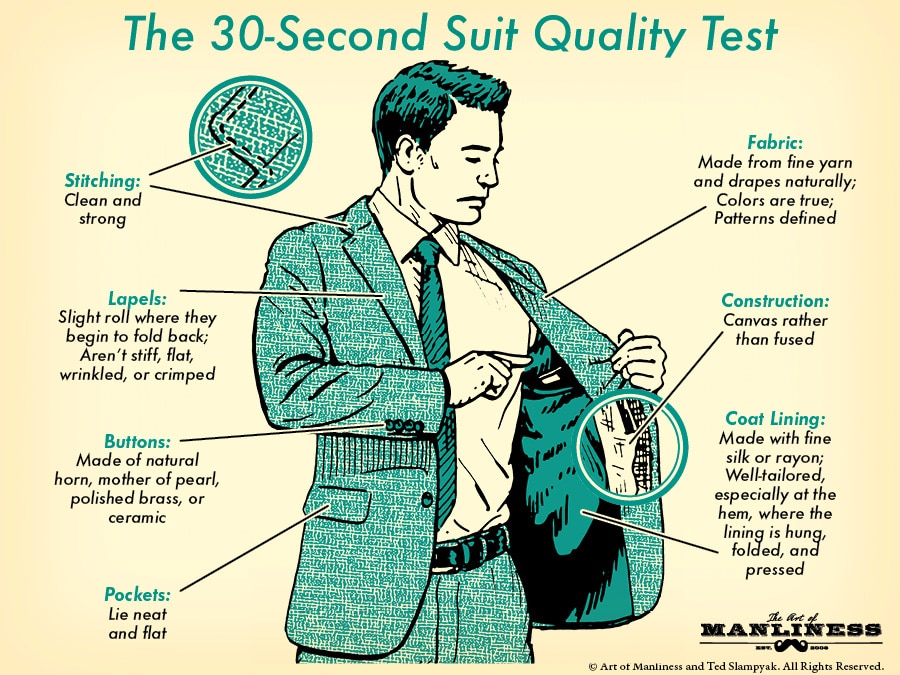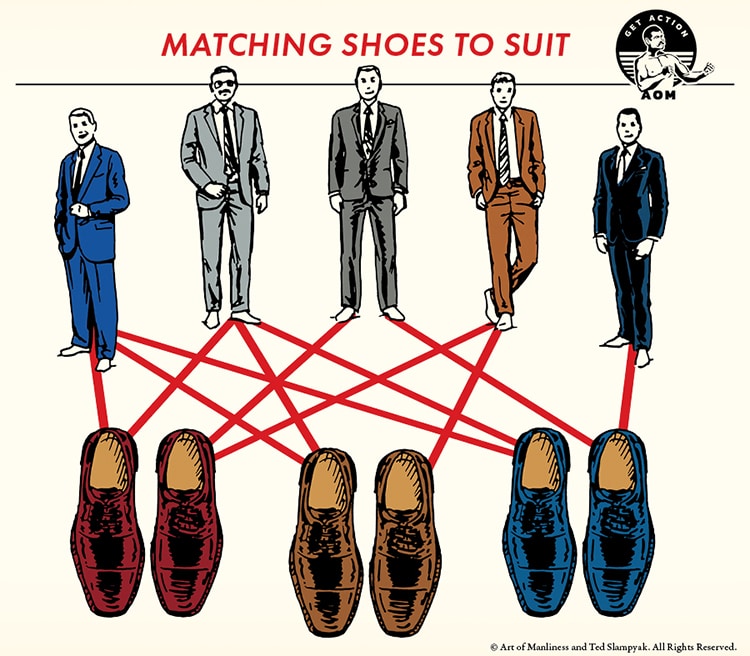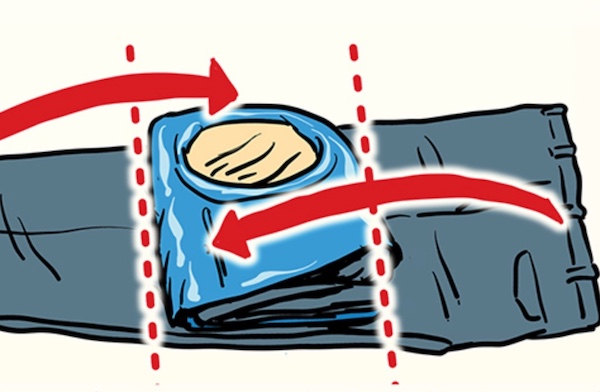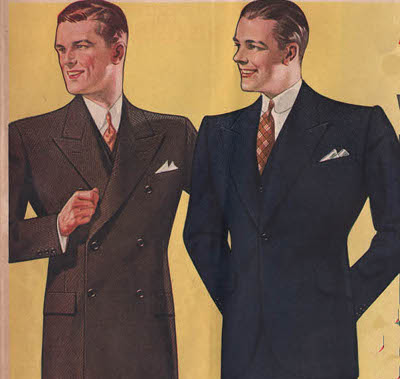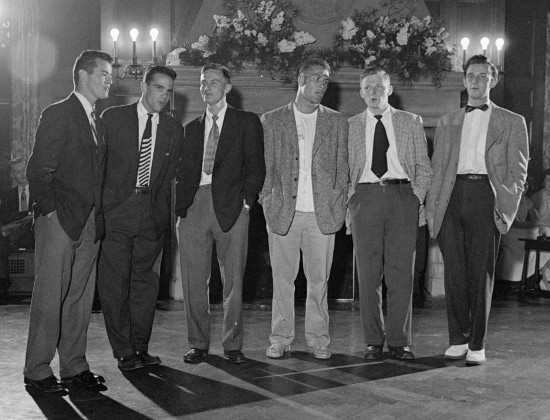
Sports jackets. Suit jackets. Blazers. Most men use these terms interchangeably, as do many men’s clothing retailers.
Because of this, the differences between these three classic menswear pieces ends up being a mystery. Are these jackets really all that different? (Yes, they are!) And why should a man even care to take the time to learn these details?
Let me give you three reasons:
1) It’ll save you money. Armed with this knowledge, you can buy the right jacket that will stand the test of time.
2) You’ll show respect to others. Each of these jackets has a slightly different level of formality. You don’t want to try wearing a sports jacket to an event that calls for a suit.
3) You’ll learn a bit of history. Each of these jackets has its own unique story of how it came to be. Understanding this helps you grasp the changes men have lived through over the last 150 years.
This article is aiming to once and for all sort out the main differences between these three iconic jackets.
Read on, gentlemen, and discover how these pieces can have a place in your wardrobe.
The Suit Jacket
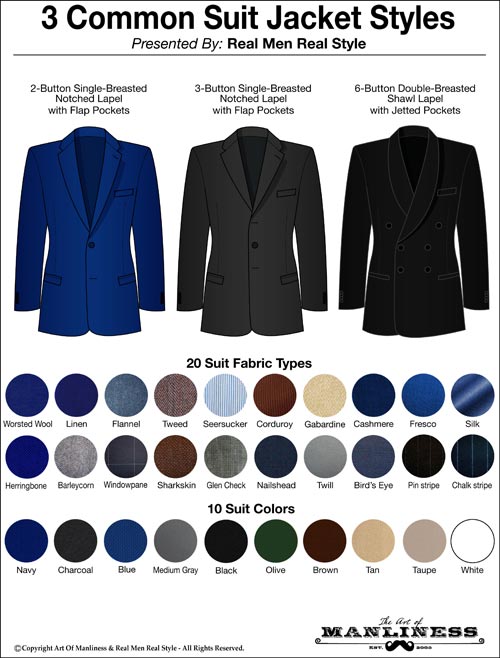
The most common jacket on the planet, and the one most men own.
A suit jacket is defined as being such only if it’s matched with trousers made from the same exact swatch of fabric.
For the vast majority of situations, you should wear suit jackets with their matching trousers. Part of the reasoning for this is that if you wear your suit jacket as a blazer — that is, pairing it with jeans or other trousers — it can wear or fade differently than the suit trousers. So the next time you go to wear that suit, it may not look congruous.
Another defining feature of the suit jacket is that it should be a closer and tighter fit than blazers/sports jackets. This is because suit jackets aren’t meant to be layered; at most, you’ll be wearing a dress shirt and thin sweater vest underneath the jacket.
If you are just learning to dress sharp, wearing a suit is the best approach for you to take to avoid the risk of looking out of place, or even worse, not knowing what you are doing.
Most Common Fabrics Used for the Suit Jacket
There are many fabrics that are used for the suit jacket. They’re distinguished from other jackets in that they’re often more lightweight and finer, and made with higher quality materials. Below are the most common:
- Worsted Wool. Created by aligning fibers and then turning them into yarn. More thin and rough than woolen wool, worsted wool is an excellent protector from cold weather.
- Cashmere. Not originally a common fabric for the suit jacket due to its durability and its price point. Cashmere is slowly starting to be the fabric of choice on a suit jacket, though, based on its extremely soft and luxurious feel, which justifies its shortfalls.
- Linen. An extremely lightweight option and meant for spring and summer use. One downside with linen is that it’s prone to wrinkling.
- Seersucker. An extremely thin form of cotton, the seersucker fabric is made for the spring and summer months. The most common colors are white and blue, and it contains distinct textures that work well with different colored trousers.
- Silk. Quite possibly the most luxurious fabric you can buy. A suit jacket made of 100% silk is extremely soft and very breathable.
Suit Jacket Colors
Given its formal nature, the suit jacket is mostly found with solid, foundation colors. For your first suit, stick with solids. But once you own a few, bringing in pin stripes, chalk stripes, windowpanes, and textured weaves makes sense in order to add variety to the wardrobe. The most common colors are:
- Navy Blue (most common)
- Charcoal Gray
- Light Gray
- Black
Common Types of Suit Jackets
Suit jackets come in all shapes and sizes. These are the three you are most likely to see:
- 2-Button Single-Breasted. The most common variety of suit jacket you can purchase. Timeless versions have a notched lapel and flapped pockets to create structure and definition.
- 3-Button Single-Breasted. Not as common as the 2-button variety. An ideal option for taller men as it helps frame their body well. You generally only want to button the middle button with this option. (Remember to follow the Sometimes, Always, Never Rule!)
- 6-Button Double-Breasted. A much less common version of suit jacket but something worth talking about is the 6-button double-breasted suit. This version is considered highly formal and best used for special events. Just remember to leave the bottom buttons undone.
What to Pair With a Suit Jacket
- Trousers. Trousers should match their suit jacket in terms of color and material. There are exceptions such as matching jeans with an orphaned suit jacket.
- Shoes. More formal shoes look best with a suit jacket. Stick with either close-laced oxfords or brogues in either dark brown, black, or burgundy. Boots can be worn in inclement weather and dress loafers or monk straps are acceptable if you’re dressing the suit down with no tie.
The Blazer Jacket
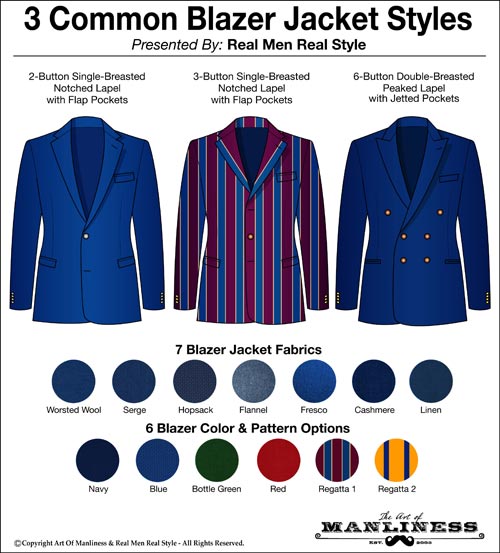
The jacket of choice of the British Navy in the early nineteenth century, the blazer exploded onto the scene after British royalty gave their approval of the garment in 1837.
Navy was the only color used at that time, and it was originally double-breasted with 6 buttons.
The single-breasted blazer has no ties to the British military and was used mostly by rowing clubs in England. These jackets only had two buttons to allow rowers the freedom to move around without restriction.
Today, you can find many varieties of the blazer jacket due to the way it highlights a man’s build. It is also one of the most versatile jackets you can own. It is often mistaken to be one and the same as the sports jacket. However, there are some subtle differences between the two that make each of them unique.
Most Common Fabrics Used for the Blazer
Fabric plays the most crucial role in the differentiation of the blazer compared to the suit and sports jackets.
The main fabrics used for the blazer are:
- Worsted Wool. Common, easy to find, but can make a blazer look like an orphaned suit jacket.
- Serge. Usually clear finished, serge has been a staple fabric in military uniforms for many years. Typically has a flat, diagonally-shaped rib pattern.
- Cashmere. Soft and luxurious, a 100% cashmere blazer is a great option to pair with chinos. Durability is a small issue but quality of the cashmere plays a role in this as well.
- Flannel. Most often created from wool or cotton, flannel is a soft weave usually woven in twill.
- Fresco. A rare fabric, created from multiple yarns in wool, the fresco fabric is usually created in a plain weave. A great fabric for the summer due to its thin lining but not recommended as an all-season fabric.
Blazer Jacket Colors
Navy blue is the color of choice for the blazer. They can also come in lighter shades, but past a certain point they start to resemble sports jackets. If you only own one blazer, make it navy.
Blazer jackets can also come in bright, vibrant colors, especially when associated with clubs and boating events. Green, red, and bright stripes are occasionally seen and have significance, as they identify the wearer as a club member or part of a team.
Common blazer jacket colors:
- Navy blue
- Blue
- Bottle green
- Red
- Regatta stripe (varies widely)
Common Types of Blazers
- 2-Button Single-Breasted. Pretty common among blazers. Quite possibly the most versatile piece you can own, especially if you get one in a foundation color such as navy blue.
- 3-Button Single-Breasted. 3-buttoned blazers are slowly gaining acceptance in menswear to compete with its two-button counterpart. The 3-button blazer is ideal for men taller than 6 feet. Pairing a 3-buttoned blazer with different color trousers will provide further balance for taller men as well.
- 6-Button Double-Breasted. A 6-button double-breasted blazer with jetted pockets is synonymous with formal wear. You will generally find peaked lapels on blazers over the notched variety, but this feature is anything but exclusive.
What to Pair With a Blazer Jacket
- Trousers. Gray flannel trousers look excellent when wearing a navy blue blazer. Classic light-colored chinos or well-fitted khakis are a less formal alternative. Jeans can be worn with a blazer; however, this is an informal outfit. For those with no fear, blazers can surprisingly be paired well with bright-colored pants in red, orange, or green. Again, not for the faint of heart, but doable for the dandies out there.
- Shoes. Given the versatility of the blazer, a wide variety of shoes can be worn with them. They look best when the shoes work well with the formality of the trouser. Gray flannels call for cleaner lines of a dark blucher or elegant double monk strap. Chinos call for a more casual loafer or derby.
The Sports Jacket
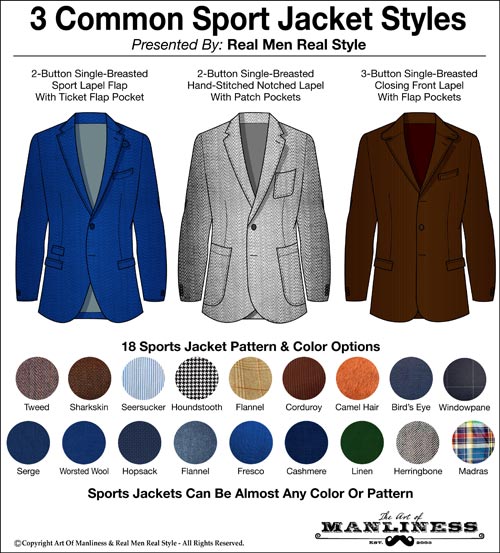
Last but definitely not least in our comparison today is the sports jacket.
Back in the day, gentlemen used to wear “morning” jackets paired with trousers of a different color. These jackets, along with full suits, were strictly used for sporting activities such as shooting. Such outfits were not yet considered appropriate formal wear.
Over time, a new type of jacket was designed specifically for men engaging in active pursuits. Termed the “Norfolk jacket,” it had a distinct fabric and build, and was in essence the very first version of the sports jacket. The Norfolk jacket was made from thicker material and was unique in having a belt with a fastening buckle around the waist to raise the comfort level of men participating in the sport of shooting.
It was not until the 1920s that the sports jacket as we now know it came to be. It offered many similarities to the Norfolk jacket, minus the belt and buckle around the waist.
The sports jacket was actually first viewed as a luxurious item, as most men could only afford a traditional suit, rather than one that had to be worn with different colored trousers. Over time, as clothing became more affordable, the sports jacket became known less as a jacket for shooting and more as a staple of sharp, casual style.
So what sets the sports jacket apart?
First off the sports jacket comes in a large variety of colors and patterns. It also isn’t as structured as suit jackets or blazers, and has a generally looser fit. A sports jacket should allow you to layer a sweater underneath and perhaps engage in slightly more rugged pursuits (comparatively speaking, of course). It also will sometimes have elbow patches on the arms, as well as a slit and pleats in the back. These design details once had a functional purpose: the patches protected the elbows from wearing out while the sporting gentleman traipsed through the countryside, while the pleats allowed him greater mobility. Today they serve simply as style statements.
The sports jacket is an extremely versatile piece, going with jeans and many types of trousers, such as ones made from corduroy, moleskin, and the ever popular grey flannel.
Plus, thanks to Italian design, the sports jacket is much more lightweight than it used to be.
Most Common Fabrics Used for the Sports Jacket
Sports jackets can most easily be identified by their use of thicker fabrics when compared to the suit jacket or blazer (although many sports jackets use lightweight fabric as well). The thicker fabric traditionally protected the wearer from the elements when these jackets were worn by gentlemen who were hunting or shooting.
Fabrics used for the sports coat can overlap the blazer and suit jacket. However, there are many that are unique and have distinctive patterns (click here for a quick infographic tutorial on fabric patterns). The most common fabrics are:
- Herringbone. A classic pattern. Look for sports jackets in this fabric to be made in browns, tans, dark grays, light grays, and blues.
- Houndstooth & Shepherd’s Check. Both are “busy” fabrics with distinctive patterns classically worn in the UK, Europe, and Northeastern United States.
- Flannel. Soft with a napped surface, flannel sports jackets are distinguished from blazers by the use of non-navy fabrics and the interweaving of other colors to create accents that bring out those same colors in a man’s shirt and accessories.
- Tweed. The perfect fabric for the sports coat given its thick and rough weave. Different colored weaves are used to make some truly unique looks. Tweed comes in a wide range of colors and are especially hard-wearing.
Sports Jacket Colors
Sports jackets come in an endless variety of colors, patterns, and fabric types.
Common Types of Sports Jackets
- 2-Button Single-Breasted. Visible stitching is one of the unique and acceptable features of the sports jacket that differentiate it from the blazer. Pockets and similar features have more detail to enforce its casual roots.
- 3-Button Single-Breasted. Flap pockets are the prominent feature of the 3-button single-breasted sports coat. As with all 3-buttoned jackets, the middle button should be the only button fastened. A variation often seen is the 2 1/2, where the top button is designed not to be buttoned due to a low folding of the lapel. You also see the 2 1/2 set-up in suits.
What to Pair With a Sports Jacket
- Trousers. Blue jeans work very well with a sports jacket, especially if they are dark and fit well. This pairing is an equal balance of stylish and casual. To dress up a sports jacket, wear any odd trouser that doesn’t too closely resemble the jacket’s fabric. Also ensure the trouser’s fabric doesn’t compete for attention (such as having a pattern if the sport jacket does), and is of a similar weight. This last one is tricky, as many men try to match heavyweight tweeds with lightweight dress slacks; this rarely works as well as a solid-colored flannel or corduroy trouser.
- Shoes. Much like the blazer jacket above, the footwear you choose depends heavily on your trouser choice. If you go with jeans, you want to keep the shoes dress casual at most. Dress boots, slip-on loafers, and double monks all work here. If you’re wearing a dressier pair of dark slacks with a lightweight and sleek sports jacket in gray, then black bluchers or tassel loafers are perfect.
Suit Jackets vs. Blazers vs. Sports Jackets in Summary
Although not entirely different from each other, each of the jackets discussed today offer enough subtle differences to set them apart.
There is no one jacket that is better than the other; it all depends on your need and the occasion.
Each jacket offers its own unique advantages that will help you look sharp based on the environment you are in.
Watch the Video
Here are other classic AoM articles that go deeper on these subjects.
- Guide to Wearing a Sports Jacket
- Guide to the Blazer Jacket
- How Suits, Sport Jackets, and Blazer Jackets Should Fit
- A Tailored Suit’s Educational Guide To Suits & Formalwear Clothing
- How to Wear a Sports Jacket With Jeans
- 4 Sports Coats for a Well Rounded Wardrobe
_______________________________
Written By Antonio Centeno
Founder, Real Men Real Style
Grab My Free Ebook – 7 Deadly Style Sins (and How To Fix Them)


